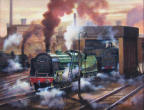Mirfield's Railways
The Manchester & Leeds Railway (renamed Lancashire & Yorkshire Railway in 1847) opened its Calder Valley line linking Hebdon Bridge and Normanton in 1840. The whole route from Liverpool to Selby was completed in 1841 and included a station at Mirfield.

click for larger image
Mirfield Booking Office

click for larger image
Mirfield Station
It missed out Huddersfield and Dewsbury so these towns had to use the stations at Cooper Bridge (for Huddersfield) and Thornhill (for Dewsbury). Huddersfield didn't have its own link line until 1847 and didn't have a station until 1850. Cooper Bridge station closed to passengers on 20th February 1950 but still maintained a small goods depot until 1963, the last 5 years being unmanned.
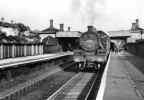
click for larger image
Battyeford Station
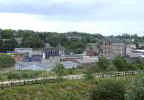
click for larger image
Battyeford Viaduct Today
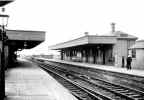 click for larger image
click for larger imageBattyeford Station
In October 1900 the "New" or Spen Valley line had been built. It was 13.25 miles long with a bridge, a 193 yard viaduct and a station at Battyeford. The line was carried on a girder bridge across the river Calder then over the viaduct to Battyeford station, pictured above. The platforms of the station extended out onto the viaduct over Huddersfield Road. The houses in the background of the left hand picture are Wilson Terrace.
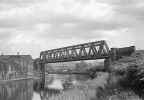
click for larger image
Girder Bridge
This is the girder bridge bringing the New Line across the Calder and onto the viaduct. The pictures above are two views of Battyeford Station which was to fall victim of Dr. Beeching's cuts in the late sixties. The first picture shows a train from Leeds standing at the platform and the second is looking through the station from the Leeds end. Most stations on The New Line had wooden platforms but Battyeford was different in that it had stone platforms. During my teenage years it had a lady station master, a Mrs. Lee who lived at Waterroyd Lane across from Stout's grocery store. The last remaining part of the viaduct is shown in the "Battyeford Viaduct Today" picture above. The station had been at the far side. Joseph Barraclough's Mill can be seen to the right of the viaduct.
 The Mirfield Viaduct carrying the Leeds New Line across the town
The Mirfield Viaduct carrying the Leeds New Line across the town
From Battyeford Station the line continued to the Mirfield viaduct which crossed Nettleton Road just below Littlemoor Grove, which was itself a goods yard and coal depot, crossed over the New Scarborough area and then over Doctor Lane at Odd Fellows Street. There is a very good aerial photo clearly showing this viaduct on the first page of Frances Stott's book "Looking Back at Mirfield". From there the line continued with a bridge across Knowl Road just above its junction with St. Paul's Road and then ran parallel with Crowlees Road where the rising terrain necessitated it having to pass through a cutting so that by the time it crossed Pinfold Lane, at its junction with Towngate, it went under the road. It continued on under Dunbottle Lane and passed the graveyard where it was spanned by a wooden footbridge and then on until it reached Shillbank Lane just below the Plough Inn where it once again crossed over the road by a bridge. Northorpe Station was originally at the far side of the bridge but in 1921 it was destroyed by fire and was later rebuilt at the Mirfield side of the bridge adjacent to the goods yard. It was renamed Northorpe Higher to differentiate it from the other Northorpe station near the Station Hotel on the Mirfield to Bradford line.
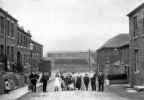
click for larger image
Northorpe Station pre 1921
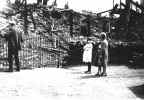
click for larger image
Northorpe Station 1921
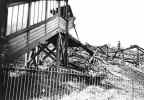 click for larger image
click for larger imageNorthorpe Station 1921
The Mirfield to Bradford line went to the left after leaving Mirfield station, passing between the canal and Mirvale Chemical Works (Mitchell Cotts today). There were sidings into the chemical works where they had their own saddle tanker, called 'Mirvale' (pictured below left), which shunted the goods trucks around the works. Following the demise of mainline steam it went to the North Yorkshire Railway in 1969 and then moved to the Middleton Railway, Leeds in December of 1985.

click for larger image
Mirvale

click for larger image
Mirvale
 click for larger image
click for larger imageMirvale
The line continued on to cross over the canal and then pass under Huddersfield Road at the junction with Church Lane. It then ran through a cutting close below the Marmaville on its way through the fields below the church. When it reached Shillbank Lane it passed over the road on a bridge and on the other side of the bridge was the other Northorpe Station close to Clarkson Street and the Station Hotel.
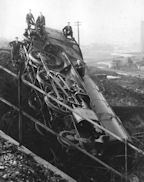
click for larger image
Derailed Engine 1962
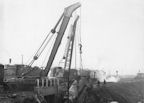
click for larger image
Lifting the Engine
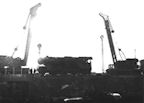
click for larger image
Back on the rails
On January 4, 1962 the steam engine, V2 60954, was derailed and turned over down the embankment near the chemical works and is pictured above. It was pulling a goods train that had been diverted onto a siding to allow an express to pass and it over-ran the buffers. Cranes were brought in from Wakefield and Darlington to put it back on the rails. The engine was only slightly damaged but was taken out of service in November 1963 and it went to scrap in January 1964. The photographs are reproduced here by courtesy of Ronald Ellis who was an engineer at the chemical works at the time.
There had been a similar accident forty years earlier in January 1922 when a Leeds and Yorkshire Railways engine was derailed to the east of Mirfield Station. This engine was re-railed four days later.
Even farther back in time, on March, 28 1895 a Manchester to Leeds goods train overturned just outside of the station. An express goods train from Liverpool collided with it and another train from Leeds ran into the debris. The driver and stoker of the first train were both killed.
Another local crash occurred in May 1948 when a coal carrying freight train crashed into the rear of an empty passenger train at Heaton Lodge. The freight train and four of its coal wagons were derailed but no-one was hurt.
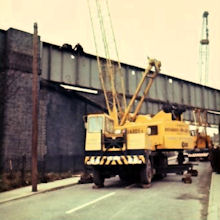
Removing the Doctor Lane railway bridge
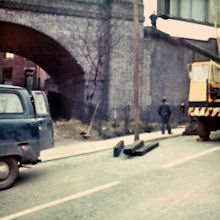
Entrance into Oddfellows Street
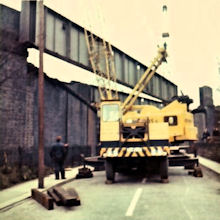 1967
1967The three photos above were taken in 1967 and show the dismantling of the railway bridge that spanned Doctor Lane. This was part of the Mirfield Viaduct that carried the Leeds New Line across Mirfield. Oddfellows Street can be seen through one of the arches in the right hand photo.
Mirfield Goods Depot and Engine Shed.
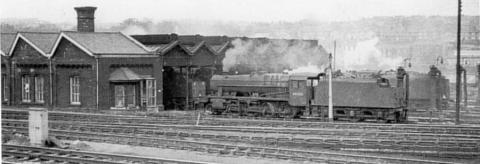 Mirfield Engine Shed
Mirfield Engine Shed
Up until the late sixties Mirfield was the site of a busy locomotive depot and sorting sidings. Mirfield engine shed had a turntable so the steam engines could be turned round for coupling to the trains that were assembled from trucks brought here from many other areas.
The shed closed to steam engines on 2nd January 1967 when the newly opened diesel depot at Healey Mills started operations. The engine shed still survived as home to Patterson's road tankers but was finally demolished in 2007 to make way for housing. All around Mirfield station were numerous railway lines with points crisscrossing between them. Seeing the simple rails we have today, it is difficult to visualise the hive of activity it used to be.

click for larger image
Engine Shed heyday
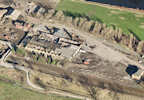
click for larger image
Engine Shed Demolition
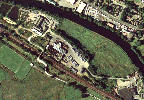 click for larger image
click for larger imageEngine Shed aerial view
These three photos, above, span the life of the engine shed from its heyday in the 1960s through to the demolition work starting in 2007.
Mirfield Reporter - April 25, 1953
The "death sentence" has been issued to two of Mirfield's three railway stations; but local people are seeking a reprieve. Notices, stating that all new line stations are to be closed, have been circulated by the railway executive, which means that the two local stations, Northorpe (higher) and Battyeford, will cease to operate a public service.
Already there are signs of strong public rejection to this, for letters of protest have been forwarded to the Mirfield District Council, the local MP and the railway authorities and regular passengers on the line have drawn up petitions.
The Rev. Peter Spivey (curate at Mirfield Parish Church) who is taking an active part in the protests, appeals to those who travel on the line daily to press the district councils of Mirfield and Heckmondwike to do their utmost to bring their cases before the British Railways Executive and preserve this amenity and retain for them a passenger service on the line in question.
Over 40 workpeople use Northorpe station each day and they complain that the nearest Leeds bus service
is about a 20 minute walk from the village and is only an hourly service. Travellers to Huddersfield would
first have to go by local bus to Ravensthorpe or Mirfield and then risk getting on early morning workers'
buses. In addition to these regulars, a number of shoppers use the line to both Leeds and Huddersfield
each week and on Saturdays, when Huddersfield Town play at home, over 70 supporters travel on the special
trains from Northorpe alone.
Mirfield Reporter - February 11, 1967
It was reported that work had begun on the demolition of six railway bridges in Mirfield. These were the five bridges that carried the railway over roads at Northorpe near the Plough, Knowl Road at its junction with St. Paul's Road, Doctor Lane, Nettleton Road, and Huddersfield Road at Battyeford. The sixth bridge was the multigirder bridge that crossed the river Calder at Battyeford.
On these pages I can only touch on the railway system that we once enjoyed but if anyone would like to learn more about it then I can recommend 3 books that cover the railways passing through our area and have relevance to Mirfield and the surrounding districts.
Railway Memories No. 13
The Leeds New Line
-
-
ISBN: 1871233135
ISBN: 0853613699
